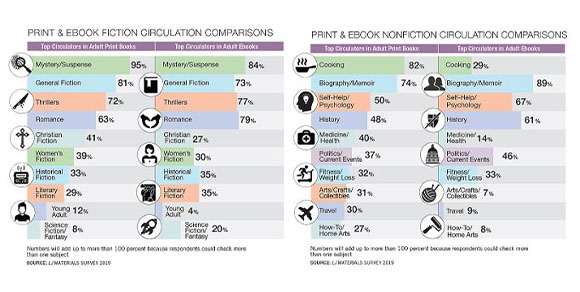
Library Journal recently released the results of its annual materials survey tracking circulation statistics in public libraries nationwide.
Materials circulation in public libraries decreased by half a percent (0.5%) in 2018, falling, though only slightly, for the first time since 1999. Two in 5 (40%) survey respondents reported that they saw their circulation decrease. Nearly 3 in 5 (57%) items circulated in 2018 were books, 1 in 10 (9%) were ebooks, and about a third (31%) were other media like audiobooks, DVD/Blu-ray, music CDs, and streaming media. Book and ebook circulation both increased from 2017 to 2018, while netted media circulation decreased.
Like in previous years the majority of materials circulated were fiction (64%). Nonfiction made up a little over a third (36%) of items circulated. Half (51%) of items circulated were adult materials, 2 in 5 (41%) were children’s materials, and about 1 in 12 (8%) were items for young adults.
The fiction genres that respondents cited as their top 5 most popular print book circulators were mystery/suspense (95%), general fiction (81%), thrillers (72%), romance (63%), and Christian fiction (41%). The genre order changes slightly for ebook circulation – mystery/suspense is still the most popular (84%), but romance moves up to second (79%), thrillers remain in third (77%), and historical and literary fiction, not present in the print top five, are tied for fourth (both at 35%).
In print nonfiction, cooking reclaimed its top spot as the most popular circulator in 2018, with 4 in 5 (82%) respondents ranking it in their top 5. Rounding out the most popular print circulators were biography/memoir (74%), self-help/psychology (50%), history (48%), and medicine/health (40%). Like in the fiction rankings, nonfiction genre popularity changes for ebook circulation. Biography/memoir (89%), self-help/psychology (67%), and history (61%) are still popular, while cooking drops to 6th place (29%). Current events/politics (46%) and fitness/weight loss (33%) are more popular in ebook format than in print.
The full report can be found here.
Note: This post is part of our series, “The LRS Number.” In this series, we highlight statistics that help tell the story of the 21st-century library.